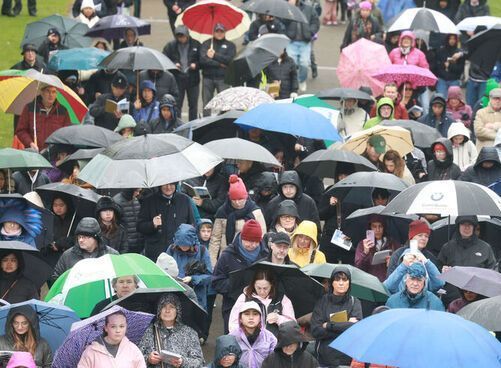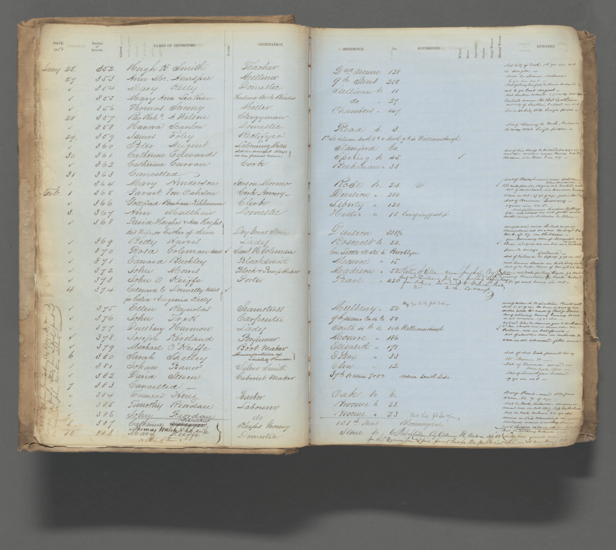Elaine Gannon, now known as Catholine Butler, at the base of the Celtic Cross at Martindale Pioneer Cemetery.
By Maura De Freitas
Along the banks of the Gatineau River in Western Quebec, just north of Canada’s National Capital Region, lies a small rural community with deep Irish roots.
In the Township of Low, a unique memorial stands in testament to the survivors of Ireland’s Great Hunger who settled in this area.
Situated in the old graveyard at St. Martin’s parish, the monument consists of a triple cenotaph with a listing of names of those buried there along with a magnificent 12-foot Celtic cross.
Inscribed at the base of the Celtic cross in English, French and Irish are the following words: “May the light of heaven shine on the souls of the Gaels who left Ireland in the years of the Great Famine to find eternal rest in this soil. They will be remembered as long as love and music last.”
This coming Sunday, September 18, a special ceremony will be held at Martindale Pioneer Cemetery to unveil a plaque with information about the individuals who worked to put the memorial in place.
Over the years, countless visitors have stopped by the site to look up their ancestors and reflect on the hardships and immense struggle of those early settlers.
Many have expressed deep gratitude for the memorial, but often they wonder how it came about, and what happened to the original headstones in the cemetery.
There is a very compelling story behind this monument and it dates back to the early 1960s when a young mother, Elaine Gannon, pregnant with her fourth child, began to visit the graveyard.
The old cemetery had been long abandoned and many of the headstones engraved with shamrocks and harps were covered in bramble.
During her visits, Elaine became aware of the high number of infant and maternal mortality rates of those settlers in the late 1800s.
Many young women and babies were buried in the old graveyard.
At the time Elaine was very ill herself with German measles and while praying for help from her ancestors, she vowed to commit herself to restoring their burial ground if she could survive her pregnancy.
She already had three small children who needed their mother, but she knew this child was not viable.
In those years, the Catholic Church held sway in Quebec and termination of a pregnancy was impossible - regardless of the circumstances.
In the end, Elaine survived, but her child did not.
For almost a year afterward Elaine struggled to regain her health, but when she finally recovered she never forgot her promise.
As soon as she could gather enough strength, she began to focus on restoration of the old graveyard.
Unfortunately, the parish priest took a very difficult stance and obstructed any such effort.
He declared she was not qualified to undertake this task and university scholars were the only ones who could undertake the project.
In addition, he insisted the best way to restore the burial ground was to demolish everything and start from the beginning.
And this is exactly what happened.
One Sunday morning a huge trench was dug and all the headstones were pushed into it and covered over.
The destruction was devastating for Elaine, but this was an era where to challenge the parish priest was to risk exclusion from the rest of the community.
So the entire matter was hushed over and put to rest.
As shocking as all this seems, Elaine became custodian of the only listing of those buried on the site as all official records related to the old graveyard disappeared from the parish.
She had been granted a one-night only reprieve by the parish priest to view those records, this in a moment of benevolence prior to the destruction.
Painstakingly, all night long, Elaine wrote out in longhand a list of those interred in the cemetery, and for years she kept those names close to her.
Elaine and her husband went on to open an Irish pub in Ottawa, Ontario, known as the Molly Maguires.
It was the first authentic Irish pub in the area, and with live Irish entertainment nightly it was wildly successful.
Elaine established an entertainment agency and started to book Irish groups on tours across North America.
Throughout these years her passion for the old graveyard never dimmed and it was these Irish musicians who encouraged her and offered to help.
A number volunteered to play at a fundraiser to help establish a memorial for those buried in Martindale.
By this time, the site of the old cemetery had become a cow pasture with history covered over and a distant memory for many locals.
So it was in the early 1970s that Elaine began work to restore the names on a monument with the help of her musicians and a number of friends in the Ottawa Irish community.
Two prominent local men, Martin Brown and Eddie McLaughlin, stepped forward to stand beside her and offered support with the project.
Another woman, Bernice McSheffrey, offered help with research.
It was with their assistance that enough money was finally raised to put the triple cenotaph in place with a listing of all the names of those buried on the site.
It wasn’t until the 1980s that the Celtic cross was finally added to the site.
This was the result of an anonymous benefactor whose identity has never been revealed.
Belfast artist, Ethna O’Kane, designed the Celtic cross depicting the story of crossing across the Atlantic on the coffin ships with the loss of so many women and children in mind.
It was unveiled 34 years ago on September 19, 1982.
While the names of those buried are recorded on the cenotaph and their story conveyed through the design on the Celtic cross, the names of those responsible for the memorial were lost in time.
Now, only one of these key people who worked on the project remains.
Her name has changed.
The former Elaine Gannon is now known as Catholine Butler following a second marriage to a County Mayo man living in Vancouver, British Columbia.
She was instrumental in helping to launch The Celtic Connection newspaper in Western Canada which has served Celts across the region for the past 25 years.
Now, it is her most fervent wish to ensure that the correct information on Martindale Pioneer Cemetery be available in years to come for all – particularly descendants of those who found peace and prosperity in this new land.
For more background and history go to https://www.facebook.com/Martindale-Pioneer-Cemetery-Low-Quebec-163911180303714.
Maura De Freitas is a founding partner of the The Celtic Connection newspaper based in Vancouver. For 25 years she has worked as managing editor and publisher of the newspaper which serves over 35,000 Canadian Celts across Western Canada and the U.S. Pacific Northwest.









